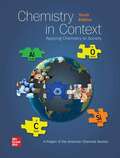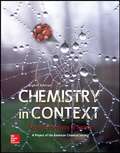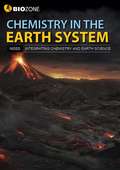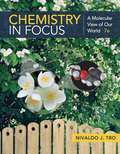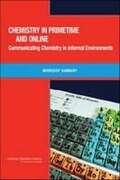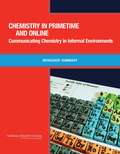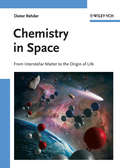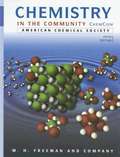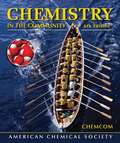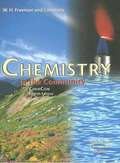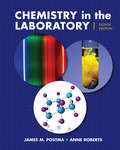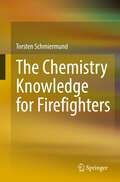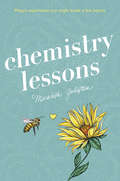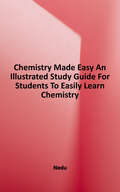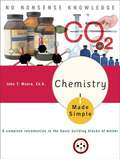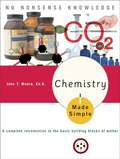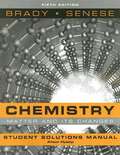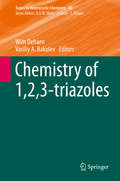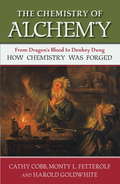- Table View
- List View
Chemistry in Context: Applying Chemistry to Society
by Bradley D. Fahlman Kathleen Purvis-Roberts John S. Kirk Resa M. Kelly Patrick L. Daubenmire American Chemical Society StaffFollowing in the tradition of the first nine editions, the goal of this successful, issues-based textbook, Chemistry in Context, is to establish chemical principles on a need-to-know basis for non-science majors, enabling them to learn chemistry in the context of their own lives and significant issues facing science and the world. <p><p>The non-traditional approach of Chemistry in Context reflects today's technological issues and the chemistry principles within them. Global warming, alternate fuels, nutrition, and genetic engineering are examples of issues that are covered in Chemistry in Context.
Chemistry in The Earth System: Integrating Chemistry and Earth Science, NGSS
by Kent Pryor Tracey Greenwood Lissa Bainbridge-SmithNIMAC-sourced textbook
Chemistry In Focus: A Molecular View Of Our World
by Nivaldo J. TroThis updated and enhanced Seventh Edition of CHEMISTRY IN FOCUS helps students develop an appreciation for the molecular world that underlies the world we can see. From the first page to the last, Professor Tro emphasizes the connection between the atoms and molecules that compose matter and the properties of that matter. Students learn to see the world through the lens of chemistry and to find excitement and awe in the myriad of chemical processes occurring all around them all the time. This easy-to-understand text also helps students understand the major scientific, technological and environmental issues affecting our society. Innovative study aids such as Self-Check Questions, OWLv2 Adaptive Study Plans and new online “Big Picture” videos featuring the author help students maximize their success in the course.
Chemistry in Primetime and Online: Communicating Chemistry in Informal Environments
by Tina MasciangioliIt is critical that we increase public knowledge and understanding of science and technology issues through formal and informal learning for the United States to maintain its competitive edge in today's global economy. Since most Americans learn about science outside of school, we must take advantage of opportunities to present chemistry content on television, the Internet, in museums, and in other informal educational settings. In May 2010, the National Academies' Chemical Sciences Roundtable held a workshop to examine how the public obtains scientific information informally and to discuss methods that chemists can use to improve and expand efforts to reach a general, nontechnical audience. Workshop participants included chemical practitioners (e. g. , graduate students, postdocs, professors, administrators); experts on informal learning; public and private funding organizations; science writers, bloggers, publishers, and university communications officers; and television and Internet content producers. Chemistry in Primetime and Online is a factual summary of what occurred in that workshop. Chemistry in Primetime and Online examines science content, especially chemistry, in various informal educational settings. It explores means of measuring recognition and retention of the information presented in various media formats and settings. Although the report does not provide any conclusions or recommendations about needs and future directions, it does discuss the need for chemists to connect more with professional writers, artists, or videographers, who know how to communicate with and interest general audiences. It also emphasizes the importance of formal education in setting the stage for informal interactions with chemistry and chemists.
Chemistry in Primetime and Online: Communicating Chemistry in Informal Environments
by The National Academy of SciencesIt is critical that we increase public knowledge and understanding of science and technology issues through formal and informal learning for the United States to maintain its competitive edge in today's global economy. Since most Americans learn about science outside of school, we must take advantage of opportunities to present chemistry content on television, the Internet, in museums, and in other informal educational settings. In May 2010, the National Academies' Chemical Sciences Roundtable held a workshop to examine how the public obtains scientific information informally and to discuss methods that chemists can use to improve and expand efforts to reach a general, nontechnical audience. Workshop participants included chemical practitioners (e. g. , graduate students, postdocs, professors, administrators); experts on informal learning; public and private funding organizations; science writers, bloggers, publishers, and university communications officers; and television and Internet content producers. Chemistry in Primetime and Onlineis a factual summary of what occurred in that workshop. Chemistry in Primetime and Onlineexamines science content, especially chemistry, in various informal educational settings. It explores means of measuring recognition and retention of the information presented in various media formats and settings. Although the report does not provide any conclusions or recommendations about needs and future directions, it does discuss the need for chemists to connect more with professional writers, artists, or videographers, who know how to communicate with and interest general audiences. It also emphasizes the importance of formal education in setting the stage for informal interactions with chemistry and chemists.
Chemistry in Space: From Interstellar Matter to the Origin of Life
by Dieter RehderThe dynamic field of extraterrestrial chemistry brings together ideas of chemistr, astrophysics, and biology to the study of molecules between stars, around stars, and on plantes. This book serves as an introduction to chemial processes under ?unearthly? and hence usually extreme conditions (temperature, pressure, high or low density, bombardment by cosmic rays), and their impact on the early development of our solar system, as well as providing a deeper understanding of processes in earthly regions where conditions approach those of extraterrestrial areas. A unique and extraordinary perspective written with chemists in mind. An excellent practical book for inorganic, and physical chemists, spectroscopists, astronomers, and libraries. From the contents: * Introduction and technical notes * Origin and development of the universe * Stars * The interstellar medium * The solar system * Exoplanets * The origin of life
Chemistry in the Community
by American Chemical Society"Chemistry in the Community is a post-secondary chemistry course structured around applied community issues related to chemistry rather than around specific chemical concepts. Concepts are presented on a ""need-to-know"" basis, allowing students to experience chemistry on first hand. The course is about 50% laboratory-based, and features activities where students must apply their chemistry knowledge to realistic decision-making situations."
Chemistry in the Community
by American Chemical Society"Chemistry in the Community is a post-secondary chemistry course structured around applied community issues related to chemistry rather than around specific chemical concepts. Concepts are presented on a ""need-to-know"" basis, allowing students to experience chemistry on first hand. The course is about 50% laboratory-based, and features activities where students must apply their chemistry knowledge to realistic decision-making situations."
Chemistry in the Community: Chemcom
by American Chemistry SocietyNIMAC-sourced textbook <P><P>Touted as the most successful NSF-funded project published, Chemistry in the Community (ChemCom) by the American Chemical Society (ACS) offers a meaningful and memorable chemistry program for all levels of high school students. ChemCom covers traditional chemistry topics within the context of societal issues and real-world scenarios. Centered on decision-making activities where students are responsible for generating data in an investigating, analyzing that data and then applying their chemistry knowledge to solve the presented problem. The text is intensively laboratory-based, with all 39 of the investigations integrated within the text, not separate from the reading. With the ChemCom program, students learn more organic and biochemistry, more environmental and industrial chemistry, and more on the particulate nature of matter than other textbooks all within the relevance of solving problems that arise in everyday life. <P><P>Meticulously updated to meet the needs of today's teachers and students, the new sixth edition of ChemCom adheres to the new science framework as well as the forthcoming next generation of science standards. Incorporating advances in learning and cognitive sciences, ChemCom’s wide-ranging coverage builds upon the concepts and principles found in the National Science Education Standards. Correlations are available showing how closely aligned ChemCom is to these and other state standards
Chemistry in the Community (4th Edition)
by American Chemical SocietyChemistry in the Community (ChemCom) is a year-long high school chemistry course for college-bound students, structured around community issues related to chemistry. The course is about 50% laboratory-based, and features decision-making activities which give students practice in applying their chemistry knowledge in realistic decision-making situations. Concepts are presented on a "need-to-know" basis, allowing students to experience the use and application of their chemistry learning, leading to a greater sense of motivation and a feeling of ownership of their new knowledge. Because of the nature of the issues covered in the specific units, students learn more organic and biochemistry than in traditional courses, as well as some environmental and industrial chemistry.
Chemistry in the Community (ChemCom), Sixth Edition
by American Chemical SocietyThe book offers a meaningful and memorable chemistry program for all levels of high school students and covers traditional chemistry topics within the context of societal issues and real-world scenarios. Centered on decision-making activities where students are responsible for generating data in an investigating, analyzing that data and then applying their chemistry knowledge to solve the presented problem.
Chemistry in the Laboratory (Eighth Edition)
by James M. Postma Anne RobertsFor nearly 40 years, Chemistry in the Laboratory has been meeting the needs of teachers and students. This new edition builds on that legacy while addressing cutting-edge trends in the chemistry laboratory—including forensic chemistry and environmental and green chemistry. As always, the new edition of Chemistry in the Laboratory offers precise, easy-to-follow instructions, helpful illustrations, and an emphasis throughout on laboratory safety. Again, throughout, a Consider This feature encourages users to expand the principles of the experiment into interesting applications, open-ended experiments, or unexplored corners. Most experiments in the manual can be completed in one lab session, but some can be linked or extended for a multi-lab project.
The Chemistry Knowledge for Firefighters
by Torsten SchmiermundChemical facts taught in firefighting training courses are often "isolated facts." In the book, these facts are integrated into an overall chemical-physical concept. Backgrounds are illuminated, and connections can be recognized. The overall understanding is facilitated, tactical measures for the operation become "logical".This book is a translation of the original German 1st edition Das Chemiewissen für die Feuerwehr by Torsten Schmiermund, published by Springer-Verlag GmbH Germany, part of Springer Nature in 2019. The translation was done with the help of artificial intelligence (machine translation by the service DeepL.com). A subsequent human revision was done primarily in terms of content, so that the book will read stylistically differently from a conventional translation. Springer Nature works continuously to further the development of tools for the production of books and on the related technologies to support the authors.
Chemistry Lab Manual
by Christopher D. Coyle Bob Jones University Press StaffA chemistry laboratory is anything but boring. Laboratories are places where exciting discoveries are made, old ideas are challenged, and new ideas are formed. But a laboratory can't do any of those exciting things on its own. It needs a chemist.
Chemistry Lab Manual SBVC Chem 104 105
by Spencer L. Seager Michael R. SlabaughChemistry Lab Manual: SBVC Chem 104/105
Chemistry Lessons
by Meredith GoldsteinFrom advice columnist Meredith Goldstein, a dazzling, romantic, and emotionally resonant YA debut about a teen science whiz in Cambridge, Massachusetts, who tries to crack the chemical equation for lasting love and instead wreaks havoc on herself and the boys in her life. For seventeen-year-old Maya, the equation for happiness is simple: a dream internship at MIT + two new science nerd friends + a perfect boyfriend = one amazing summer. Then Whit dumps her out of the blue. Maya is miserable until she discovers that her scientist mother, before she died, was conducting research on manipulating pheromones to enhance human attraction. If Maya can finish her mother’s work, maybe she can get Whit back. But when her experiment creates chaos in her love life, she realizes that maybe love and loss can’t be understood using the scientific method. Can she learn to trust the unmeasurables of love and attraction instead?
Chemistry Made Easy
by NeduWhile Chemistry is a huge topic, it's not necessary to spend years studying it unless it's your major in college. For most of us, we need a clear grasp of the subject to progress through school. This book has you covered. You will surely not be a chemistry newbie after reading this. You will learn that chemistry is about matter. You can break matter down a great deal-all the way down to molecules, atoms, and subatomic particles. The smaller the matter, the more fascinating it gets.
Chemistry Made Simple: A Complete Introduction to the Basic Building Blocks of Matter (Made Simple)
by John T. Moore Ed.D.See the world, one molecule at a time. Chemistry helps us understand not only the world around us, but also our own bodies. CHEMISTRY MADE SIMPLE makes it fun. Each chapter has practice problems with complete solutions that reinforce learning. A glossary of chemical terms, the modern periodic table, and detailed illustrations throughout make this the best introduction to one of the most studied of all sciences.Topics covered include: *the Scientific Method *the structure and properties of matter*compounds *laws of chemistry*gases, liquids, and solids *solutions *electrochemistry*the atmosphere*biochemistry*organic chemistry *nuclear chemistry*energy *the environment Look for these Made Simple titlesAccounting Made SimpleArithmetic Made SimpleAstronomy Made SimpleBiology Made SimpleBookkeeping Made SimpleBusiness Letters Made SimpleEarth Science Made SimpleEnglish Made SimpleFrench Made SimpleGerman Made SimpleIngles Hecho Facil Investing Made SimpleItalian Made SimpleLatin Made SimpleLearning English Made SimpleMathematics Made SimpleThe Perfect Business Plan Made SimplePhilosophy Made SimplePhysics Made SimplePsychology Made SimpleSign Language Made SimpleSpelling Made SimpleStatistics Made SimpleYour Small Business Made Simplewww.broadwaybooks.com
Chemistry Made Simple, Revised Edition
by John T. MooreChemistry Made Simple was written to give you a basic understanding of chemistry, whether you are a student taking your first chemistry course or simply someone wanting to learn a bit more about the chemical world around you. The book is divided into 26 chapters, each covering a specific aspect of chemistry.
Chemistry:Matter and Its Changes (Student Solutions Manual) (Fifth Edition)
by James E. Brady Fred SeneseWritten by Jim Brady, an author well known for his ability to communicate chemistry, and Fred Senese, the architect of the most visited general chemistry Web site, this book and its media are designed to support a variety of backgrounds. It maintains its hallmark feature of accurate, lucid, and interesting explanations of the basic concepts of chemistry as well as its comprehensive coverage and aid to readers in developing problem solving skills.
Chemistry, Module J (HMH Science Dimensions™)
by Michael A. DiSpezio Marjorie Frank Michael R. HeithausNIMAC-sourced textbook
Chemistry of 1,2,3-triazoles (Topics in Heterocyclic Chemistry #40)
by Wim Dehaen Vasiliy A. BakulevThe series Topics in Heterocyclic Chemistry presents critical reviews on present and future trends in the research of heterocyclic compounds. Overall the scope is to cover topics dealing with all areas within heterocyclic chemistry, both experimental and theoretical, of interest to the general heterocyclic chemistry community. The series consists of topic related volumes edited by renowned editors with contributions of experts in the field.
The Chemistry of Alchemy
by Harold Goldwhite Cathy Cobb Monty FetterolfA unique approach to the history of science using do-it-yourself experiments along with brief historical profiles to demonstrate how the ancient alchemists stumbled upon the science of chemistry.Be the alchemist! Explore the legend of alchemy with the science of chemistry. Enjoy over twenty hands-on demonstrations of alchemical reactions. In this exploration of the ancient art of alchemy, three veteran chemists show that the alchemists' quest involved real science and they recount fascinating stories of the sages who performed these strange experiments. Why waste more words on this weird deviation in the evolution of chemistry? As the authors show, the writings of medieval alchemists may seem like the ravings of brain-addled fools, but there is more to the story than that. Recent scholarship has shown that some seemingly nonsensical mysticism is, in fact, decipherable code, and Western European alchemists functioned from a firmer theoretical foundation than previously thought. They had a guiding principle, based on experience: separate and purify materials by fire and reconstitute them into products, including, of course, gold and the universal elixir, the Philosophers' stone. Their efforts were not in vain: by trial, by error, by design, and by persistence, the alchemists discovered acids, alkalis, alcohols, salts, and exquisite, powerful, and vibrant reactions--which can be reproduced using common products, minerals, metals, and salts. So gather your vats and stoke your fires! Get ready to make burning waters, peacocks' tails, Philosophers' stone, and, of course, gold!
